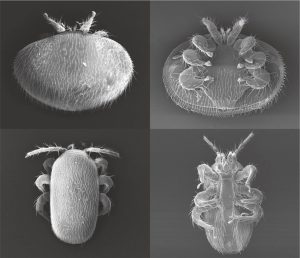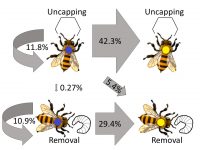We study the biotic interactions between the ectoparasitic Varroa mite and its honey bee host. Varroa is regarded by many scientists and beekeepers one of the most important causes of the honey bee health crisis. Varroa vectors viruses and weakens honey bees. Within an Integrated Pest Management (IPM) approach, we seek to develop new control methods of Varroa. On the one hand, we are working on the development and evaluation of new Varroacides. On the other hand, we study natural defenses (e.g., hygienic behaviour) of the honey bees to assist the bees and give beekeepers tools for stock evaluation and selective breeding. Hygienic brood signals have led to the development of the novel UBeeO™ assay, available from Optera. The natural coexistence of Varroa with its original host Apis cerana ( the Eastern Honey Bee) exemplifies that a sustainable solution is possible and we have a long way to go, studying the Varroa – honey bee relationship from all angles.
 |
 |
 |
Barrs K.R., Ani M.O., Eversman K.K., Rowell J.T., Wagoner K.M., Rueppell O. (2021) Time-accuracy trade-off and task partitioning of hygienic behavior among honey bee (Apis mellifera) workers. Behavioral Ecology and Sociobiology, 75:12.
Wagoner K.M., Millar J., Schal C., Rueppell O. (2020) Cuticular pheromones stimulate hygienic behavior in the honey bee (Apis mellifera). Scientific Reports, 10: 7132.
Wagoner K.M., Spivak M., Hefetz A., Reams T., Rueppell O. (2019) Varroa mites and Deformed Wing Virus elicit hygienic behavior in honey bees through stock-specific changes in brood cuticular hydrocarbons. Scientific Reports, 9: 8753.
Wagoner K.M., Spivak M., Rueppell O. (2018) Brood affects hygienic behavior in the honey bee (Hymenoptera: Apidae). Journal of Economic Entomology, 111(6): 2520-2530.
Kuster R.D., Boncristiani H.F., Rueppell O. (2014) Immunogene and viral transcript dynamics during parasitic Varroa destructor (Anderson) mite infection of developing honey bee (Apis mellifera L) pupae. Journal of Experimental Biology, 217: 1710-1718.
